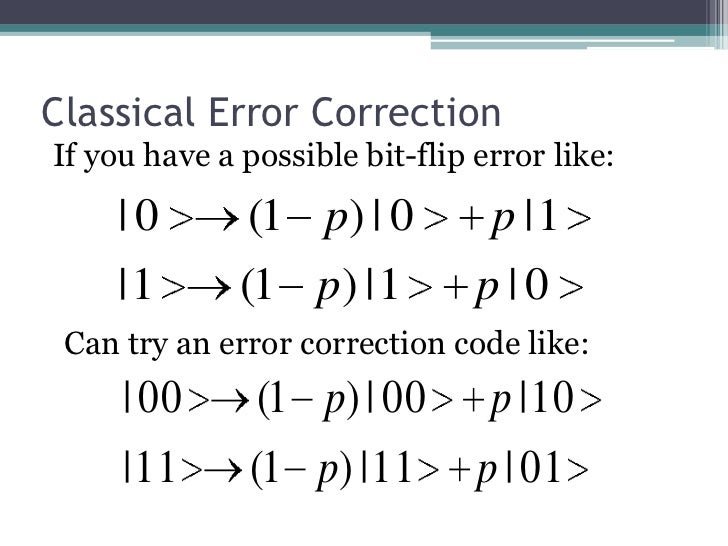
This creates a paradox, absurdly implying that-in this fictional, expanding universe-microscopic black holes convert into photons. But the extra photon wasn’t created by that special process, so instead of disappearing when you turn back time, its wavelength will eventually get impossibly small, concentrating its energy so greatly that the photon collapses into a black hole. In our real universe, this isn’t a problem: A photon shrinks only until the moment of its creation through some subatomic process the reversal of that process will make it disappear. Going into the past, the universe gets smaller, and the wavelength of photons will shrink too.
#QUANTUM ERROR CORRECTION ENCODING ISOMETRY PLUS#
Unitarity insists that we must be able to calculate what this universe looked like in the past, unswiveling its quantum state as much as we wish.īut rewinding the state of the universe plus an extra photon creates a glitch. Imagine taking the current state of the universe, said Giddings, and adding “one innocuous photon”-perhaps lodged in newly created space halfway between here and the Andromeda galaxy. Giddings sharpens the issue with a paradoxical thought experiment set in a universe that’s both unitary and expanding. “It’s related to the statement that information is neither created nor destroyed.”Īnd yet, this bedrock assumption seems to conflict with the universe that surrounds us.Īndrew Strominger, left, and Jordan Cotler of Harvard University have collaborated on an effort to replace unitarity in quantum physics with an alternative rule called isometry. “The past completely determines the future, and the future completely determines the past,” said Cotler. It will always land on another viable state in the Hilbert space, which never grows or shrinks. It’s a mathematical fact with philosophical consequences: If you know the specific unitary matrix corresponding to some change over time, any quantum state can be swiveled into the future or unswiveled into the past. Unitarity dictates that a physically allowed change must correspond to a special “unitary” matrix that rotates the particle’s state in Hilbert space without changing that the sum of the squares of its coordinates equals 1. The particle’s amplitudes correspond to its coordinates in Hilbert space, and physicists capture changes to the particle with mathematical objects called matrices, which transform its coordinates. Physicists keep probabilities and amplitudes in line by tracking how the quantum state of a particle moves around in Hilbert space-an abstract space representing all possible states available to the particle. “I was not interested in considering any theory which would not fit in with my darling,” Dirac wrote, referring to unitarity. In the 1920s, for instance, this unitarity requirement guided the British physicist Paul Dirac to discover an equation that implied the existence of antimatter. In working out how a particle is allowed to evolve or interact, physicists use the fact that amplitudes never change in a way that disrupts the fixed sum of their squares. As a particle’s state changes (as it flies through a magnetic field, say, or collides with another particle), its amplitudes change too. It’s this twist-the squaring of hidden amplitudes to calculate the outcomes we actually see-that gives unitarity teeth. We show that many previous ideas, such as the existence of a large number of "null states", a breakdown of effective field theory for operations of exponential complexity, the quantum extremal surface calculation of the Page curve, post-selection, "state-dependent/state-specific" operator reconstruction, and the "simple entropy" approach to complexity coarse-graining, all fit naturally into this framework, and we illustrate all of these phenomena simultaneously in a soluble model.Illustration: Merrill Sherman/Quanta Magazine In this paper we explain how quantum error correction nonetheless can be used to explain the emergence of the black hole interior, via the idea of "non-isometric codes protected by computational complexity".



inner-product preserving) encoding of the former into the latter. Quantum error correction has given us a natural language for the emergence of spacetime, but the black hole interior poses a challenge for this framework: at late times the apparent number of interior degrees of freedom in effective field theory can vastly exceed the true number of fundamental degrees of freedom, so there can be no isometric (i.e.


 0 kommentar(er)
0 kommentar(er)
